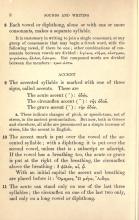9. The accented syllable is marked with one of three signs, called accents.
The acute accent (´): ὁδός
The circumflex accent (˜): τῆς ὁδοῦ
The grave accent (`): τὴν ὁδόν
a. These indicate changes of pitch, or speech-tune, not of stress, in the ancient pronunciation. But now, both in Greece and elsewhere, all alike are pronounced as a simple increase of stress, like the accent in English.
10. The accent mark is put over the vowel of the accented syllable; with a diphthong it is put over the second vowel, unless that is ι subscript or adscript. If the vowel also has a breathing mark, the acute or grave is put at the right of the breathing mark, the circumfex above.
ἒ ψῑλόν
αἵ
ᾧ
With an initial capital the accent and breathing mark are placed before it.
Ὅμηρος
Ὦ μέγα
Ἅιδης
11. The acute can stand only on one of the last three syllables; the circumflex on one of the last two only, and only on a long vowel or diphthong.
a. If, then, a vowel has the circumflex accent, it must be long, and no separate mark of length is added.
12. If the ultima is long, the acute cannot stand on the antepenult, nor the circumflex on the penult. For exceptions see § 93.b.
13. In the penult an accented long vowel or diphthong takes the circumflex, unless that is forbidden by § 12.
14. But final -αι and -οι, though long, affect the accent of penult and antepenult as if short.
ἄνθρωποι men
οἶκοι houses
a. Yet not in οἴκοι at home, nor in optative verb forms: παύοι.
15. An acute on the ultima changes to the grave when closely followed by another word.
ἀγαθὸς ἀνήρ a good man
a. This change is not made in τίς, τί interrogative (§ 217) nor before an enclitic (§ 19). Before a comma usage varies.


